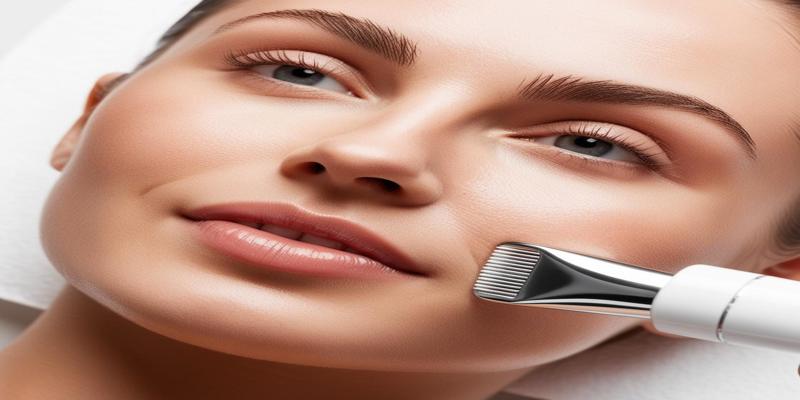Advertisement
Consider trying dermaplaning for that oh-so-desirable, baby-smooth complexion. Before you pick up that blade, you will want to know the potential pitfalls of this trendy facial treatment. Yes, dermaplaning can yield impressive results when done correctly, but lousy technique or aftercare will lead to regret and, even worse, horror stories. In this comprehensive guide, you will learn all the dos and don'ts of dermaplaning, other people's mistakes, and other valuable insights that will put you through in making a yes or no decision.
 In recent years, dermaplaning has become one of the hot skincare mainstays, particularly among beauty enthusiasts chasing smoother, more radiant skin. The process is a noninvasive technique in which the surface of the skin is delicately scraped with a sterile surgical scalpel to remove dead skin cells and vellus hair, also known as "peach fuzz."
In recent years, dermaplaning has become one of the hot skincare mainstays, particularly among beauty enthusiasts chasing smoother, more radiant skin. The process is a noninvasive technique in which the surface of the skin is delicately scraped with a sterile surgical scalpel to remove dead skin cells and vellus hair, also known as "peach fuzz."
During a dermaplaning session, an experienced aesthetician delicately glides the blade at a 45-degree angle over the face. This technique exfoliates the skin so effectively that it removes up to three weeks' buildup of dead skin cells and fine facial hair to reveal a smoother canvas. This helps products absorb better, and yields improved makeup wear.
Many are very attracted to dermaplaning due to the following benefits:
Preparing your skin before initiating the process is essential to ensure an ideal outcome with dermaplaning. Use a gentle cleanser to remove dirt, oil, or makeup from your face. Gently pat dry your face using a clean towel to remove all moisture. For best results, you can try using a mild exfoliating toner to wipe away any additional debris, making your skin smooth for dermaplaning.
One significant mistake is trying to dermaplane over active breakouts, open skin lesions, or irritated skin. Doing so might increase inflammation, possible scarring, and even infection. Always wait for your skin to heal entirely before starting the process. Consult your dermatologist for sensitive or reactive skin before the method.
Invest in a good-quality dermaplaning tool that is designed for at-home use. Hold the blade at a 45-degree angle, using short, light strokes toward hair growth. Apply light pressure and work in sections, taking extra care around sensitive areas, such as the eyes and lips. Consistency pays off, so try not to move your hand or alter the pressure too much during the process.
While dermaplaning can offer excellent results, going overboard with the treatments is not worth going overboard. Stick once every 3-4 weeks to give your skin time to regenerate between treatments. Over-exfoliating can irritate, make your skin sensitive, and even tear down your skin's protective barrier. Take the hint from your skin and adjust the frequency based on your skin type and concerns.
It may sound relatively simple, but dermaplaning doesn't have any risks. One of the most common horror stories includes treatments done by inexperienced practitioners or do-it-yourself attempts gone wrong. These situations, more often than not, result in painful skin irritation and excessive redness and may even leave scars. In worse cases, overzealous scraping has led to taking off too much skin and, thus, hypersensitivity and longer healing times.
Another common dermaplaning nightmare is infection after treatment. If you don't follow proper sterilization techniques, or if you dermaplane over active acne, you're asking for trouble. Several unlucky individuals have received severe bacterial infections, resulting in sore, swollen skin, with some cases even requiring medical attention. Others reported massive breakouts in the days after their treatment, probably because bacteria were spread all over the face during the procedure.
While it is often prescribed as a means of hair removal, sometimes dermaplaning can work against one. Many said that their facial hair had grown back thicker or even darker. While this is a myth, several have noted that dermaplaning doesn't change the hair follicles, and the skin develops a coarser regrowth due to a blunt cut from the blade. In rare cases, skin trauma has turned into hormonal fluctuations, leading to growth in facial hair and, ultimately, distress and regret.
Some of the most horrific dermaplaning stories have to do with unpredictable reactions during or after treatment with a product. Everything from severe allergic reactions to chemical burns due to intensely active post-procedure products points to patch testing and proper aftercare instructions. Always communicate with your practitioner any skin sensitivity, and introduce new products to freshly dermaplaned skin with caution.
 Skin Type and Sensitivity
Skin Type and SensitivityBefore trying dermaplaning, consider your skin type and sensitivity. This is not an exfoliation method for everyone. Very sensitive skin, skin with active acne, and the like, including conditions such as rosacea or eczema, should be handled with caution. Consult a dermatologist to determine whether your skin will endure this procedure or if adverse reactions are possible.
Evaluate your existing skincare regimen before incorporating dermaplaning. If you're already using potent active ingredients like retinoids or chemical exfoliants, adding dermaplaning might lead to over-exfoliation. This can compromise your skin barrier, resulting in irritation, redness, or increased sensitivity. Consider adjusting your routine to accommodate dermaplaning safely.
Knowing your hair growth patterns is crucial when considering dermaplaning. For some, the hair after dermaplaning might not grow back thicker or darker; the regrowth texture might change for a period. If you have hormonal imbalances involving hair growth and conditions affecting it, this procedure might not give you the desired results or heighten the issues.
It is important to note that dermaplaning is not a permanent solution; it requires regular treatment to achieve the best effect. Consider whether you can commit to consistent treatments every 3-4 weeks. Additionally, consider the necessary post-treatment care, including sun protection and gentle skincare practices. If you can't dedicate the time and effort to proper aftercare, dermaplaning isn't your best lifestyle choice.
In conclusion, dermaplaning can offer benefits when done correctly, but it's crucial to weigh the risks and follow best practices. By understanding the dos and don'ts, you can avoid joining the ranks of dermaplaning horror stories. Remember to choose a qualified professional, prepare your skin correctly, and follow aftercare instructions diligently.
Advertisement

By Georgia Vincent/Mar 17, 2025

By Isabella Moss/Jan 10, 2025

By Nancy Miller/Nov 09, 2024

By Aldrich Acheson/Mar 17, 2025

By Sean William/Mar 16, 2025

By Tessa Rodriguez/Jan 14, 2025

By Juliana Daniel/Jan 14, 2025

By Sean William/Jan 14, 2025

By Celia Shatzman/Mar 18, 2025

By Susan Kelly/Dec 21, 2024

By Noa Ensign/Nov 08, 2024

By Aldrich Acheson/Dec 21, 2024